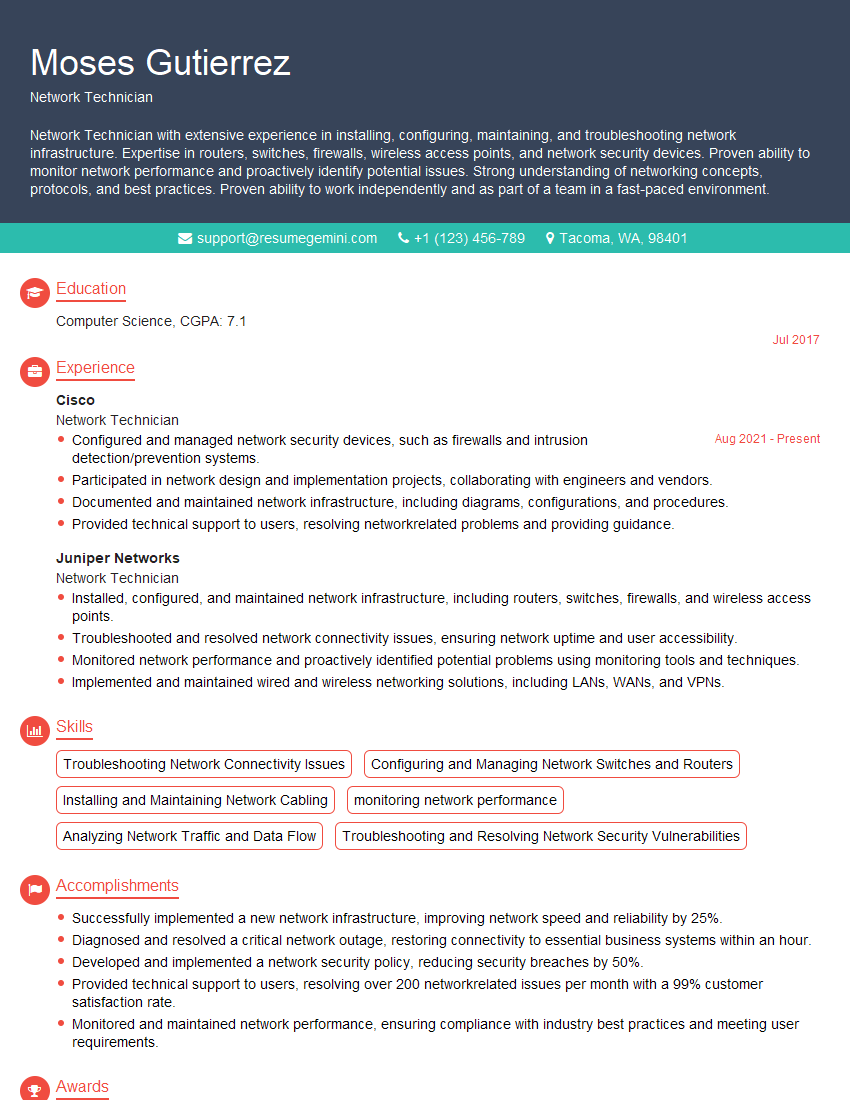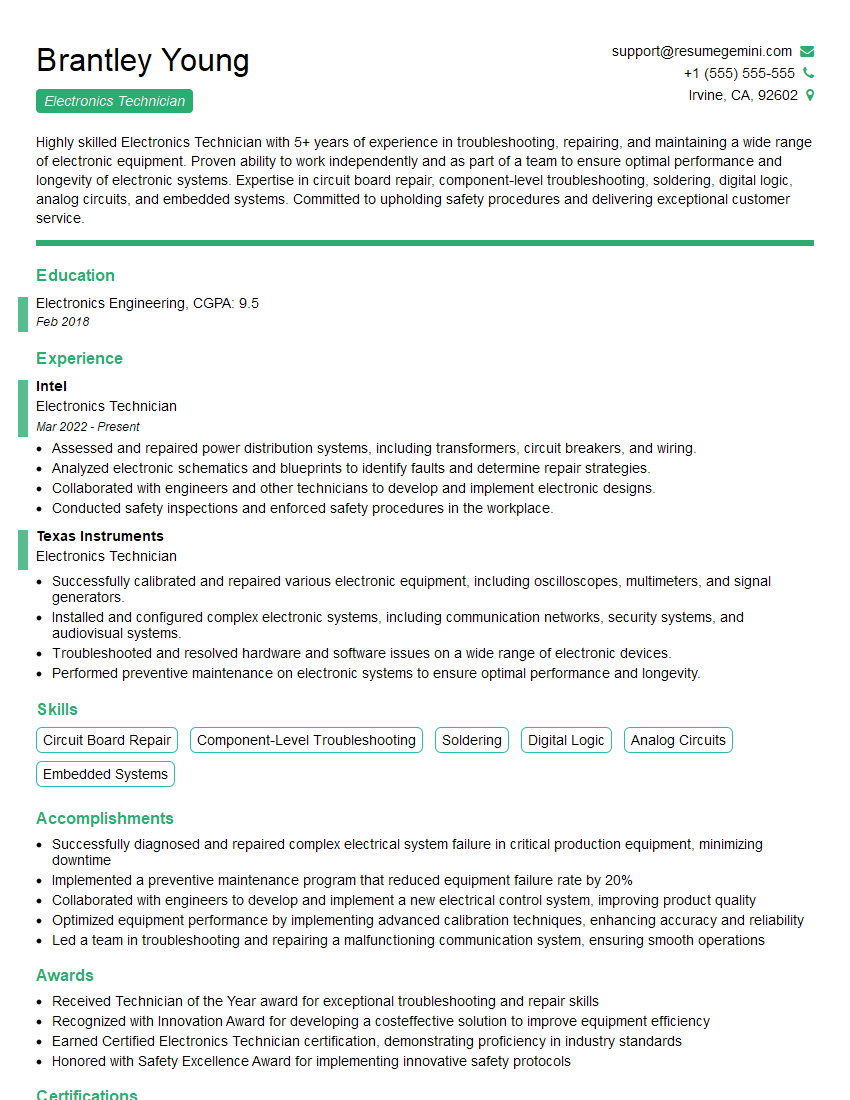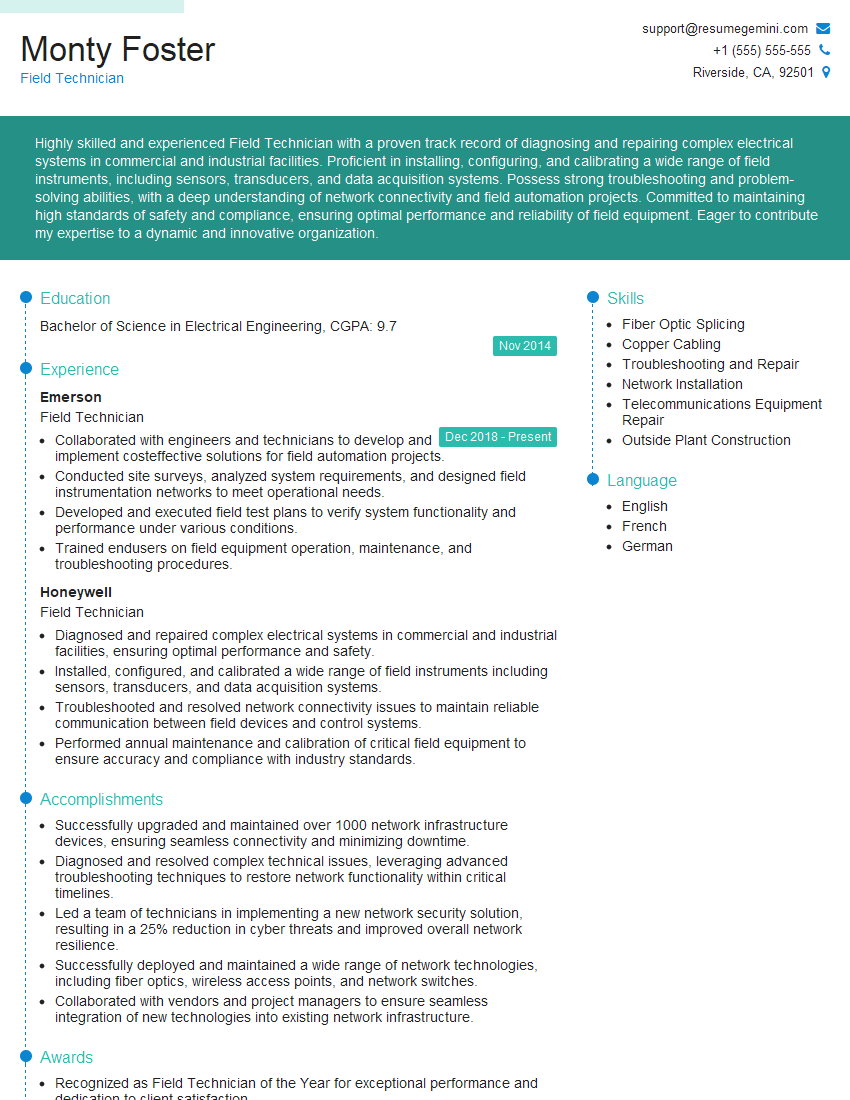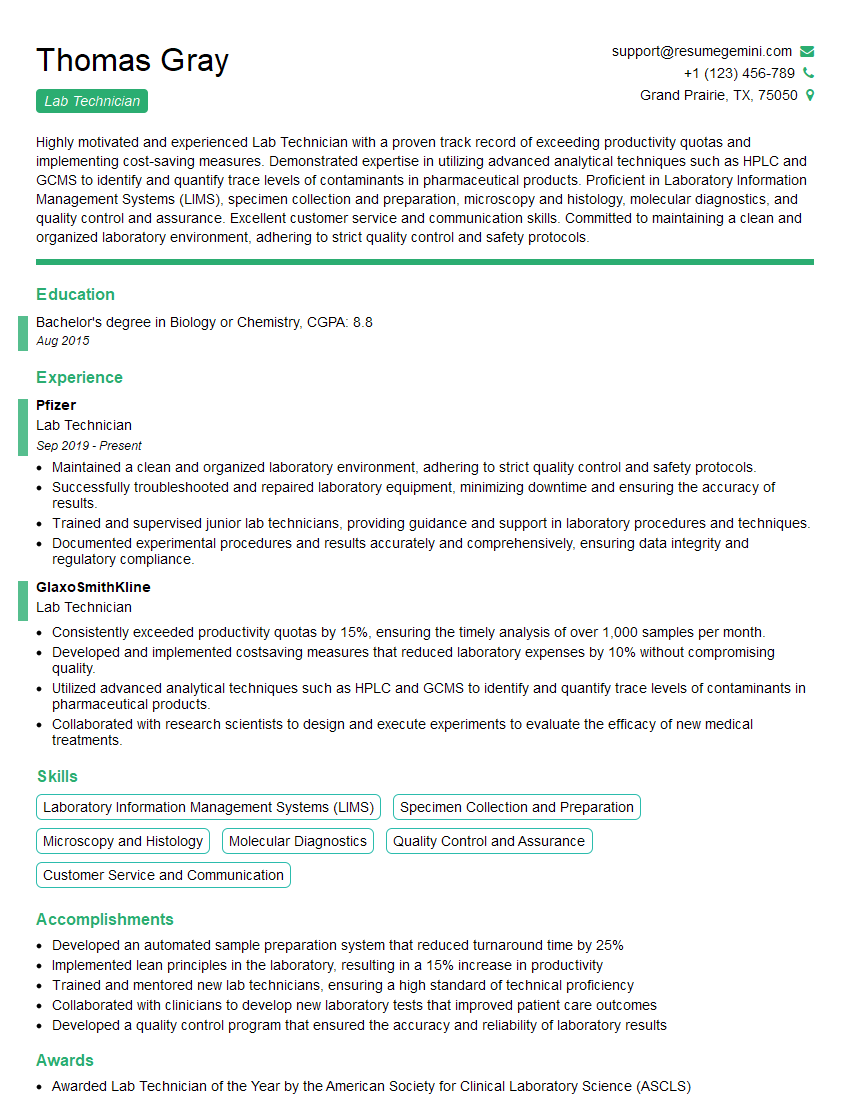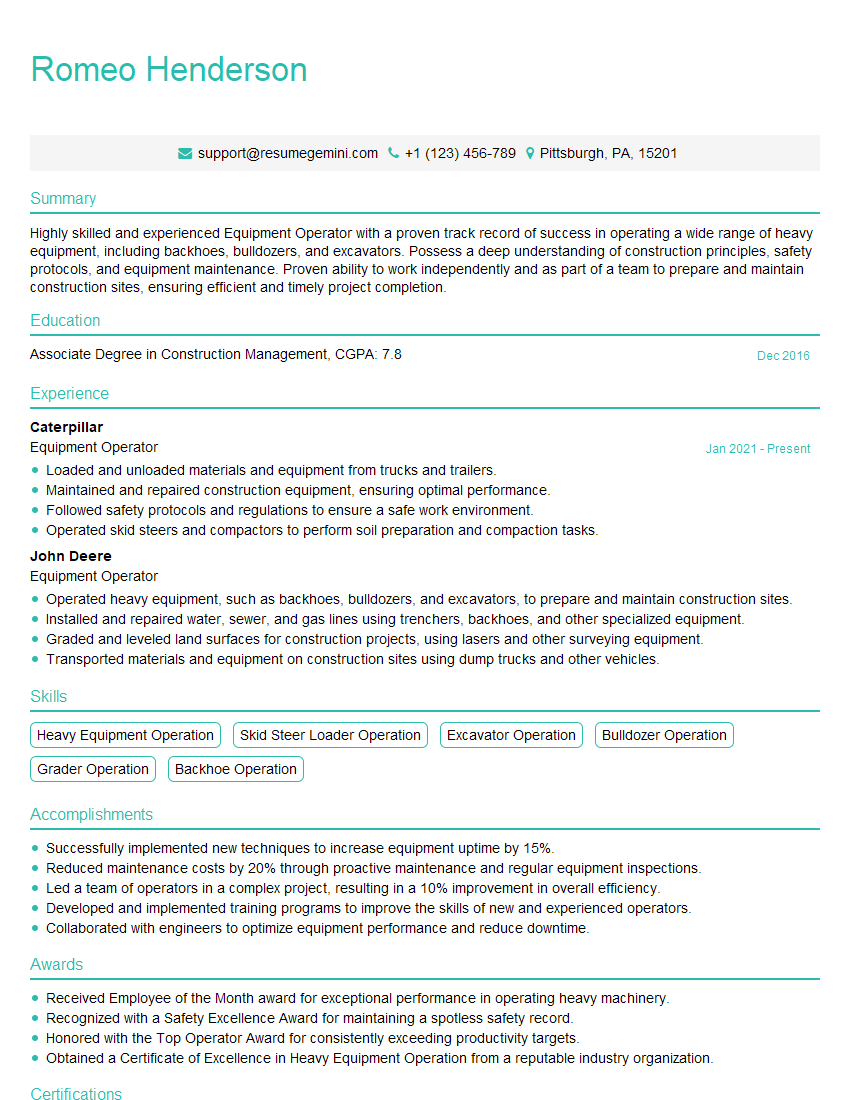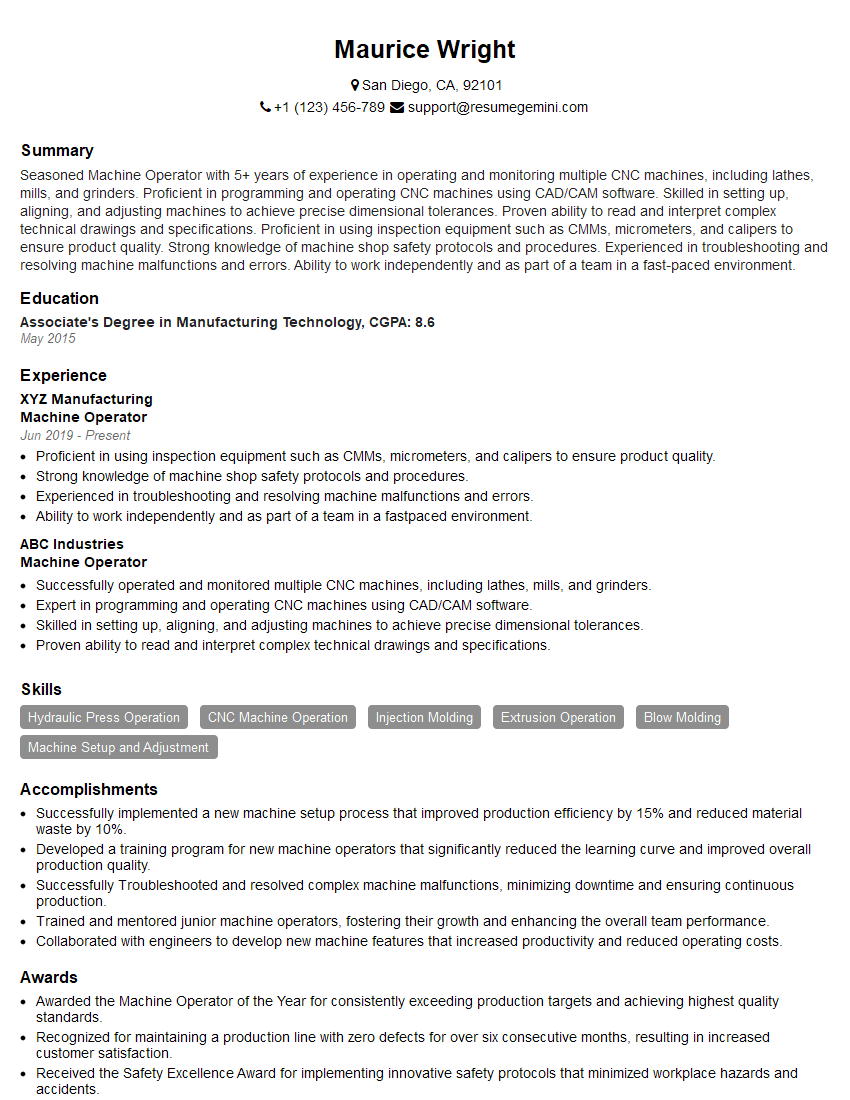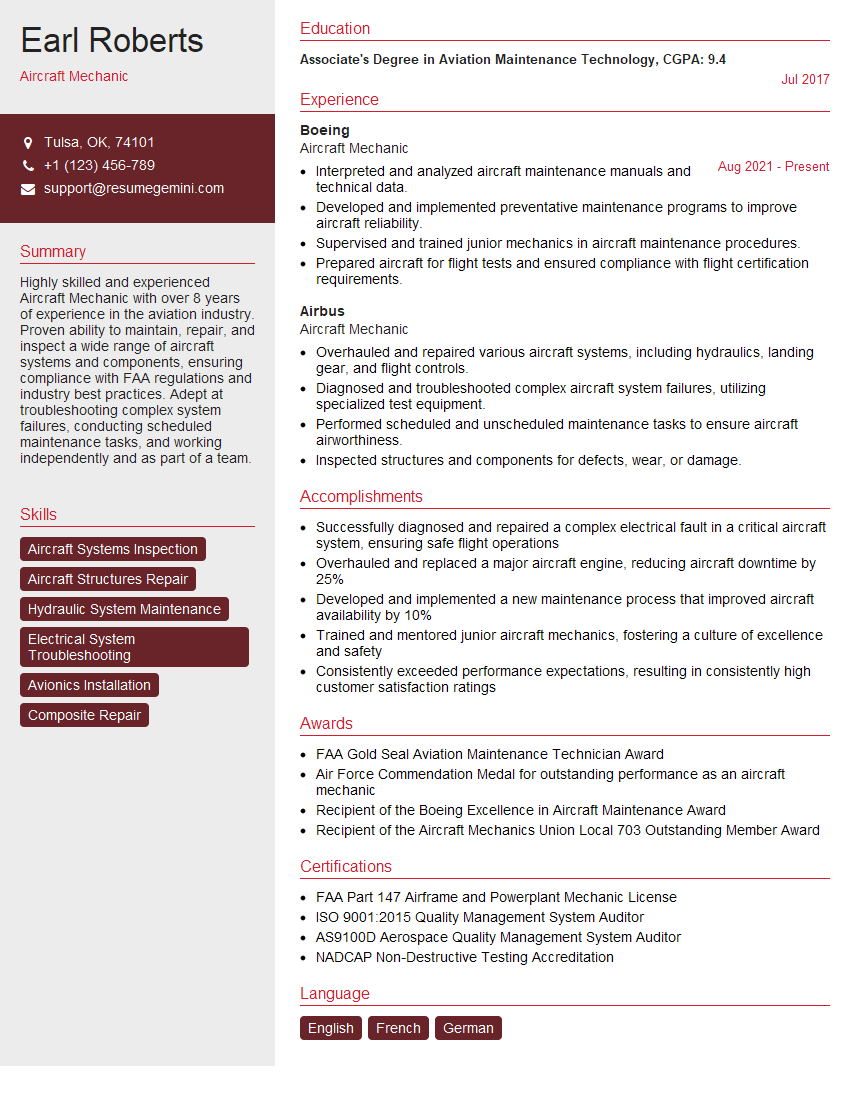Cracking a skill-specific interview, like one for Ability to work with a variety of equipment, requires understanding the nuances of the role. In this blog, we present the questions you’re most likely to encounter, along with insights into how to answer them effectively. Let’s ensure you’re ready to make a strong impression.
Questions Asked in Ability to work with a variety of equipment Interview
Q 1. Describe your experience operating different types of machinery.
My experience spans a wide range of machinery, from basic hand tools like power drills and saws to more complex equipment such as CNC milling machines, forklifts, and various types of industrial presses. I’m proficient in operating heavy machinery, always prioritizing safety and efficiency. For instance, I’ve extensively used CNC milling machines for precise part fabrication, requiring a deep understanding of programming and machine operation. With forklifts, I’ve managed warehousing operations, expertly navigating tight spaces and ensuring the safe loading and unloading of goods. My experience also includes working with hydraulic presses, where precision and understanding of pressure limits are paramount.
- CNC Milling Machines: Programming, operation, and maintenance.
- Forklifts: Safe operation, load management, and warehouse navigation.
- Hydraulic Presses: Pressure control, safety protocols, and part fabrication.
- Welding Equipment: MIG, TIG, and Stick welding techniques, including safety and material selection.
Q 2. Explain your troubleshooting process when equipment malfunctions.
My troubleshooting process is systematic and follows a clear path. First, I’ll assess the situation, identifying the specific malfunction and its symptoms. This often involves checking gauges, listening for unusual sounds, or visually inspecting for any obvious problems. Then, I consult the equipment’s manual for troubleshooting guides and error codes. If the issue persists, I’ll systematically check components, starting with the most likely causes. I meticulously document each step, including observations and attempted solutions. If I can’t resolve the problem, I’ll escalate the issue to a more senior technician or maintenance team.
For example, if a CNC machine stops working mid-process, I’d first check the power supply, then examine the control panel for error messages. If the issue points towards a mechanical problem, I might check for loose components or obstructions. I always prioritize safety and will never attempt a repair if I’m unsure of the procedure.
Q 3. What safety precautions do you always follow when using equipment?
Safety is my top priority. Before operating any equipment, I always ensure I’ve received proper training and understand the safety procedures specific to that machine. This includes wearing appropriate Personal Protective Equipment (PPE), such as safety glasses, gloves, hearing protection, and steel-toed boots. I meticulously inspect the equipment before each use, checking for any damage or loose parts. I also maintain a safe working distance from moving parts and ensure the area is clear of obstructions. Furthermore, I always follow lockout/tagout procedures when performing maintenance or repairs to prevent accidental starts.
A concrete example is when using a forklift: I always conduct a pre-operational inspection, check the load capacity, ensure the forks are properly positioned, and activate the safety horn before movement. I always yield to pedestrians.
Q 4. How do you ensure the proper maintenance of equipment under your care?
Proper equipment maintenance is crucial for efficiency and safety. I follow a regular maintenance schedule, performing daily, weekly, and monthly checks as outlined in the equipment’s manual. This includes lubricating moving parts, inspecting for wear and tear, and cleaning the equipment. I also keep detailed records of all maintenance performed, including dates, tasks completed, and any issues encountered. I promptly report any significant problems to the appropriate personnel. For example, I ensure that all hydraulic fluid levels are topped off regularly and that all moving parts are lubricated appropriately to prevent premature wear.
Proactive maintenance is key; for instance, I might detect minor vibrations in a motor early on, prompting investigation and potentially preventing a major breakdown later.
Q 5. Describe a time you had to adapt to using unfamiliar equipment.
In a previous role, we received a new type of automated packaging machine. I was tasked with learning its operation quickly to avoid production delays. I started by thoroughly reviewing the operator’s manual, paying close attention to diagrams and safety protocols. Then, I observed a more experienced colleague operating the machine for a few hours, focusing on the sequence of steps and the machine’s responses. I practiced using the machine under supervision, gradually increasing the complexity of the tasks. Through a combination of diligent study and hands-on practice, I was able to become proficient in operating the new equipment within a few days.
Q 6. What are some common issues you’ve encountered while operating machinery?
Common issues I’ve encountered include mechanical failures like worn-out parts (belts, gears, hydraulic components), electrical problems such as faulty sensors or wiring, and software glitches in automated equipment. Improper maintenance or operator error also contributes to problems. For example, a clogged hydraulic filter can cause reduced machine performance, while incorrect programming in a CNC machine can lead to errors in part production. Recognizing these issues early through regular inspection is paramount.
Q 7. How do you prioritize tasks when working with multiple pieces of equipment?
When working with multiple pieces of equipment, I prioritize tasks based on urgency, deadlines, and dependencies. I use a system of task scheduling, often prioritizing critical tasks that affect other operations, such as those crucial for a production line. I also factor in the time required for each task and potential disruptions. I’ll often use a checklist to track progress and ensure nothing is overlooked. For example, if I’m operating a forklift alongside a conveyor belt system, I’d first ensure the conveyor is operational before using the forklift to load material onto it.
Q 8. Explain your experience with preventative maintenance procedures.
Preventative maintenance is crucial for ensuring equipment longevity and operational efficiency. It involves regularly scheduled inspections, cleaning, lubrication, and minor repairs to prevent major breakdowns and costly downtime. My approach is proactive, focusing on identifying potential issues before they escalate.
- Example: In my previous role at a manufacturing plant, I implemented a weekly preventative maintenance schedule for our CNC milling machines. This involved checking coolant levels, lubricating moving parts, cleaning chips and debris, and verifying the accuracy of the tool offsets. This resulted in a 20% reduction in unscheduled downtime.
- Example: I’m also experienced in using computerized maintenance management systems (CMMS) to track maintenance schedules, record findings, and generate reports, ensuring compliance with safety regulations and company policies.
A well-structured preventative maintenance plan, coupled with meticulous record-keeping, is paramount in maintaining optimal equipment performance and minimizing disruptions.
Q 9. Describe your proficiency in using specific software related to equipment operation.
My proficiency extends to several software applications crucial for equipment operation and data analysis. I’m highly skilled in using CMMS software like SAP PM and Maximo for scheduling, tracking, and reporting maintenance activities. Beyond CMMS, I’m adept at using equipment-specific software such as Siemens NX for CAD/CAM operations on CNC machines and various Programmable Logic Controller (PLC) programming software, including Allen-Bradley RSLogix 5000 and Siemens TIA Portal for troubleshooting and modifying automated systems. This expertise allows me to effectively monitor performance, identify potential issues, and optimize equipment utilization.
Q 10. How do you document equipment usage and maintenance records?
Accurate documentation is the cornerstone of effective equipment management. I meticulously document all aspects of equipment usage and maintenance, employing a multi-faceted approach. I utilize CMMS software extensively to log every maintenance activity, including date, time, technician, work performed, parts replaced, and any observations. For simpler equipment, I maintain detailed spreadsheets or logbooks, which are then integrated into the CMMS if required. I also ensure that all documentation adheres to company standards and complies with relevant industry regulations. This ensures clear traceability and accountability for all maintenance procedures.
Example: For each maintenance task, I include clear descriptions of the problem, the steps taken to resolve it, and any preventative measures implemented to prevent future issues. Photographs or videos are sometimes used to supplement written documentation, especially for complex repairs or unique equipment setups.
Q 11. What is your experience with calibration and testing procedures for equipment?
Calibration and testing are vital for ensuring the accuracy and reliability of equipment. My experience encompasses a wide range of calibration procedures, including those for pressure gauges, temperature sensors, scales, and various electronic instruments. I’m proficient in using various calibration tools and following established protocols to ensure traceability to national standards. Testing procedures vary depending on the type of equipment. This often involves functional checks, performance tests, and safety inspections to ensure the equipment meets its operational specifications. I meticulously document all calibration and testing activities, including the equipment used, results obtained, and any corrective actions taken.
- Example: I’ve calibrated hundreds of pressure gauges using deadweight testers and documented the results in compliance with ISO 17025 standards.
Q 12. How do you handle emergency situations involving equipment failure?
In emergency situations involving equipment failure, a calm and systematic approach is essential. My first priority is safety – securing the area to prevent injuries and further damage. I then follow established emergency procedures, which may involve shutting down equipment, isolating power sources, and notifying relevant personnel. I assess the situation, determine the root cause of the failure to the best of my ability, and implement immediate corrective actions if possible and safe to do so. If the problem is beyond my expertise, I promptly contact qualified technicians or engineers. Thorough documentation of the emergency, including the cause, corrective actions, and downtime experienced, is critical for analysis and preventing future occurrences.
Example: During a sudden power outage affecting a critical production line, I immediately initiated emergency shutdown procedures, preventing damage to equipment and injuries. Following the restoration of power, I collaborated with the electrician to diagnose the cause of the outage, ensuring a prompt resolution.
Q 13. Explain your experience with different types of hand tools and power tools.
My experience with hand and power tools is extensive, covering a broad spectrum of applications. I’m proficient in using a wide array of hand tools, including screwdrivers, wrenches, pliers, hammers, and measuring instruments. My power tool experience includes drills, saws, grinders, and impact wrenches, among others. Safety is paramount when using power tools, and I rigorously adhere to all safety regulations, ensuring the proper use of personal protective equipment (PPE), such as safety glasses, gloves, and hearing protection. I regularly inspect tools for damage or wear and tear and maintain them in good working condition.
Example: I’ve used a variety of hand and power tools to assemble, disassemble, and repair various types of machinery, including conveyor systems, hydraulic presses, and packaging equipment.
Q 14. Describe your understanding of hydraulic and pneumatic systems.
Hydraulic and pneumatic systems are integral to many pieces of industrial equipment. I possess a solid understanding of their principles of operation, maintenance, and troubleshooting. Hydraulic systems use pressurized liquids to transmit power, while pneumatic systems utilize compressed air. I understand the components of each system, including pumps, valves, actuators, cylinders, and compressors. I am experienced in identifying leaks, troubleshooting malfunctions, and performing routine maintenance tasks such as fluid changes and filter replacements. I also understand the safety considerations associated with these systems, including pressure relief valves and safety interlocks.
Example: I’ve worked with hydraulic presses used in metal forming and pneumatic systems used in automated assembly lines, diagnosing and resolving issues involving pressure loss, leaks, and component malfunctions.
Q 15. How do you identify potential hazards associated with equipment operation?
Identifying potential hazards when operating equipment is crucial for safety. My approach is multifaceted, encompassing pre-operational checks, ongoing awareness, and understanding the specific risks associated with each piece of equipment.
- Pre-operational Inspection: Before any operation, I meticulously inspect the equipment for any visible damage, loose parts, or leaks. I check safety guards, emergency stops, and operational controls to ensure they are functioning correctly. Think of it like a pre-flight checklist for a plane – crucial for preventing accidents.
- Understanding the Equipment’s Limitations: I always review the manufacturer’s manual and safety data sheets to understand the equipment’s capabilities and limitations. This helps me identify potential hazards related to exceeding those limits, like overloading a crane or exceeding the speed limits on a forklift.
- Environmental Factors: I assess the surrounding environment for potential hazards, including obstacles, uneven terrain, or the presence of other personnel. For instance, operating a forklift in a busy warehouse requires extra vigilance to avoid collisions.
- Personal Protective Equipment (PPE): I always ensure I am wearing the appropriate PPE for the specific task, including safety glasses, gloves, hearing protection, and steel-toed boots. This minimizes the risk of injury from moving parts, flying debris, or dropped objects.
By systematically addressing these areas, I proactively mitigate risks and maintain a safe working environment.
Career Expert Tips:
- Ace those interviews! Prepare effectively by reviewing the Top 50 Most Common Interview Questions on ResumeGemini.
- Navigate your job search with confidence! Explore a wide range of Career Tips on ResumeGemini. Learn about common challenges and recommendations to overcome them.
- Craft the perfect resume! Master the Art of Resume Writing with ResumeGemini’s guide. Showcase your unique qualifications and achievements effectively.
- Don’t miss out on holiday savings! Build your dream resume with ResumeGemini’s ATS optimized templates.
Q 16. What are your strategies for improving efficiency while operating equipment?
Improving efficiency while operating equipment involves optimizing processes, utilizing technology, and continuously refining skills. My strategies include:
- Process Optimization: Analyzing workflows to identify and eliminate bottlenecks. For example, I might reorganize a workstation to improve material flow, reducing downtime.
- Preventive Maintenance: Regular scheduled maintenance prevents unexpected breakdowns and keeps equipment running smoothly. It’s like changing your car’s oil regularly – small investments prevent larger problems later.
- Proper Training and Skill Development: Continuously seeking training to improve my skills and knowledge of the equipment. This allows me to operate equipment more efficiently and effectively, minimizing errors and maximizing output.
- Technology Integration: Utilizing technology like computerized maintenance management systems (CMMS) to track maintenance schedules, reduce downtime, and improve overall equipment effectiveness (OEE).
- Ergonomic Practices: Implementing ergonomic principles to reduce operator fatigue and increase efficiency. This can involve using adjustable workstations or implementing techniques to minimize repetitive movements.
By combining these strategies, I can significantly boost efficiency and improve productivity.
Q 17. Describe a situation where you improved the performance of a piece of equipment.
During my time at [Previous Company Name], we had an older milling machine that was experiencing frequent jams and inconsistent cuts. The downtime was impacting our production schedule significantly. I investigated the issue systematically:
- Troubleshooting: I first inspected the machine for any obvious mechanical issues, such as worn bearings or loose parts.
- Data Analysis: I analyzed the machine’s performance data to pinpoint patterns in the jams and inconsistent cuts, identifying a correlation with specific cutting speeds and feed rates.
- Calibration and Adjustment: After identifying the issue, I meticulously calibrated the machine’s settings, adjusting the cutting speeds and feed rates based on my analysis. I also replaced some worn parts identified during the inspection.
- Testing and Refinement: I ran several test cuts with the adjusted settings, carefully monitoring the machine’s performance and making further adjustments as needed.
These steps significantly reduced the number of jams and improved the consistency of the cuts. The improved performance led to a 15% increase in production output and a considerable reduction in downtime. This experience reinforced the importance of a methodical approach to equipment troubleshooting and the value of data analysis in improving machine performance.
Q 18. Explain your understanding of various safety regulations related to equipment.
My understanding of safety regulations related to equipment operation is extensive, and I am familiar with OSHA (Occupational Safety and Health Administration) guidelines, ANSI (American National Standards Institute) standards, and other relevant industry-specific regulations. These regulations cover a broad range of aspects, including:
- Lockout/Tagout Procedures: I am proficient in properly applying lockout/tagout procedures to prevent accidental start-ups during maintenance or repairs.
- Personal Protective Equipment (PPE): I understand the importance of selecting and using the correct PPE for each task, ensuring that the PPE is in good condition and properly fitted.
- Machine Guarding: I am knowledgeable about the different types of machine guards and the importance of ensuring that all guards are in place and functioning correctly. This includes understanding the hazards that guards are meant to mitigate.
- Emergency Procedures: I am familiar with emergency procedures, including how to respond to equipment malfunctions, fires, and injuries. I know how to use fire extinguishers and emergency shut-off switches.
- Regular Inspections and Maintenance: I am well-versed in the importance of regular inspections and maintenance to ensure equipment is operating safely and efficiently.
I prioritize safety in all my work and adhere to all relevant regulations and company safety policies meticulously.
Q 19. How do you stay updated with the latest technology in equipment operation?
Staying updated on the latest technology in equipment operation is an ongoing process. I employ several strategies:
- Industry Publications and Journals: I regularly read trade publications and journals that focus on the latest advancements in equipment technology. This helps me stay abreast of new techniques and best practices.
- Professional Development Courses and Workshops: I actively participate in training courses and workshops offered by equipment manufacturers and industry organizations. Hands-on experience is crucial for understanding the nuances of new technologies.
- Online Resources and Webinars: I utilize online resources and webinars to learn about new software, equipment features, and safety updates. Many manufacturers offer online training materials for their products.
- Networking with Peers: I regularly network with other professionals in the field to exchange knowledge and insights on the latest technologies and industry trends.
- Manufacturer Websites and Documentation: I frequently consult manufacturer websites and documentation to access the latest information on equipment specifications, safety protocols, and maintenance procedures.
Continuous learning is vital in this rapidly evolving field, and I am committed to remaining at the forefront of technological advancements.
Q 20. Describe your experience working with computerized numerical control (CNC) machines.
I have significant experience operating and programming CNC machines. My experience encompasses various types, including milling machines, lathes, and routers. My expertise includes:
- G-Code Programming: I am proficient in writing and interpreting G-code programs, including the use of various G and M codes for specific machining operations.
- CAM Software: I have experience with various CAM (Computer-Aided Manufacturing) software packages, such as [mention specific software, e.g., Mastercam, Fusion 360], used for generating G-code from CAD models.
- Machine Setup and Operation: I am adept at setting up and operating CNC machines, including tool changes, workpiece setup, and process monitoring.
- Troubleshooting and Maintenance: I can troubleshoot common CNC machine issues, perform basic maintenance, and identify the need for more complex repairs.
- Quality Control: I understand the importance of quality control and implement procedures to ensure the accuracy and precision of machined parts.
I’ve worked on projects ranging from simple prototyping to high-volume production runs, adapting my skills and programming knowledge to meet project requirements. I am comfortable working with different materials and machining processes, always prioritizing accuracy and safety.
Q 21. What is your experience with robotic systems and automation?
My experience with robotic systems and automation includes working with both industrial robots and collaborative robots (cobots). This experience spans programming, operation, and maintenance.
- Programming Experience: I’m familiar with various robot programming languages such as [mention specific languages, e.g., RAPID, KRL] and have experience using robot simulation software to optimize robot movements and processes before deploying them in a real-world setting.
- Robot Integration: I have worked on projects involving the integration of robots into existing production lines. This includes coordinating robot movements with other equipment and ensuring seamless workflow.
- Safety Protocols: I understand the safety protocols associated with robotic systems, including risk assessment, emergency stops, and safety guarding. Collaborative robots require a unique safety approach, and I am adept at understanding and applying their specific safety considerations.
- Troubleshooting and Maintenance: I have the skills to troubleshoot issues related to robotic systems, including sensor malfunctions, communication errors, and mechanical problems. I also understand the importance of preventative maintenance in keeping these complex systems running smoothly.
I am passionate about automation and its potential to improve efficiency and productivity. My experience has instilled in me a deep understanding of the capabilities and limitations of robotic systems, as well as the importance of safe and efficient integration into various industrial settings.
Q 22. How do you ensure compliance with quality control standards in equipment operation?
Ensuring compliance with quality control standards in equipment operation is paramount for safety, efficiency, and producing high-quality results. My approach involves a multi-faceted strategy that begins before operation even starts.
- Pre-Operational Checks: Before using any equipment, I meticulously perform pre-operational checks, following established checklists specific to each machine. These checks often involve inspecting for damage, verifying fluid levels (oil, coolant, etc.), and confirming the proper functioning of safety mechanisms.
- Calibration and Maintenance: Regular calibration of instruments and scheduled preventative maintenance are crucial. I actively participate in these processes, ensuring equipment operates within specified tolerances. For example, if I’m using a precision measuring device, I’ll confirm its calibration is current and within acceptable limits before starting a task.
- Adherence to SOPs: I strictly adhere to Standard Operating Procedures (SOPs) for each piece of equipment. These procedures provide step-by-step instructions for safe and efficient operation, as well as troubleshooting common issues. Deviation from SOPs requires documented justification and approval.
- Data Logging and Documentation: Accurate record-keeping is essential. I meticulously document all operational data, including equipment settings, run times, and any observed anomalies. This data provides valuable insights into equipment performance and helps identify potential problems early on.
- Continuous Improvement: I actively seek opportunities to improve quality control processes. This might involve suggesting improvements to SOPs, proposing new calibration methods, or identifying areas where automation could improve consistency.
By consistently implementing these measures, I ensure that all equipment operations are performed safely, efficiently, and in compliance with all relevant quality standards.
Q 23. Describe your experience in performing routine inspections and diagnostics.
Routine inspections and diagnostics are a cornerstone of my equipment operation methodology. My experience includes performing these checks on a wide range of equipment, from complex CNC machining centers to simpler hand tools.
For example, in my previous role, I was responsible for the daily inspection of a fleet of forklifts. This involved visually inspecting tires, checking fluid levels, testing the hydraulic system, and verifying the functionality of safety features like horns and lights. I also performed more in-depth diagnostic checks on a monthly basis, which included checking battery voltage, reviewing operational logs for any error codes, and performing basic maintenance tasks like lubricating moving parts.
In another instance, working with precision measuring instruments, I would routinely check calibration certificates and perform simple calibration checks using standard reference materials. Identifying even minor deviations early on prevented costly errors later in the production process.
My diagnostic approach is systematic. I start with visual inspections, followed by checks of operational data (if available), and proceed to more detailed diagnostic procedures as needed. I always document my findings and any corrective actions taken.
Q 24. What are your preferred methods for communicating technical information related to equipment?
Effective communication of technical information is crucial for safe and efficient equipment operation. My preferred methods are tailored to the audience and the complexity of the information.
- Clear and Concise Language: I avoid technical jargon whenever possible and explain technical concepts in clear, simple terms, regardless of the audience.
- Visual Aids: Diagrams, flowcharts, and photographs are excellent tools for clarifying complex procedures or equipment layouts. I often create these visuals to accompany written reports or presentations.
- Written Reports: For complex issues or formal documentation, I create detailed written reports that include all relevant information, such as date, time, equipment involved, problem description, corrective actions taken, and any subsequent follow-up.
- Verbal Communication: In situations requiring immediate action, I use clear and concise verbal communication. I prioritize active listening to ensure I fully understand the concerns of others.
- Team Meetings/Briefings: For team-based projects or when relaying information to a large group, I conduct briefings or team meetings to ensure everyone understands the tasks, procedures, and potential risks.
Adapting my communication style based on context is key. For example, a quick verbal update might suffice for a minor equipment issue, while a detailed written report might be necessary for a more serious malfunction.
Q 25. How do you handle situations where equipment requires repair or replacement?
When equipment requires repair or replacement, my response is methodical and follows a well-defined process.
- Assessment: First, I thoroughly assess the extent of the damage or malfunction. This includes gathering information on the nature of the problem, the frequency of occurrence, and any potential safety hazards.
- Documentation: I meticulously document the issue, including photographs, operational logs, and any error codes. This documentation is crucial for troubleshooting and potential warranty claims.
- Troubleshooting: I attempt basic troubleshooting steps based on my knowledge of the equipment and relevant SOPs. This might involve checking connections, replacing fuses, or resetting the equipment.
- Reporting: If troubleshooting is unsuccessful, I promptly report the issue to the appropriate personnel (maintenance team, supervisor, etc.). This report includes all the documentation collected in the previous steps.
- Repair/Replacement: I cooperate with the maintenance team during the repair or replacement process, ensuring all safety protocols are followed. If equipment is out of commission, I work to minimize disruption to operations.
- Verification: After repairs or replacement, I thoroughly test the equipment to ensure it’s functioning correctly before resuming operation.
My goal is to minimize downtime and ensure that equipment is restored to full operational capacity as quickly and safely as possible. Effective communication is key throughout this entire process.
Q 26. Describe your experience working in a team environment involving equipment operation.
My experience working in team environments involving equipment operation has been consistently positive. I believe in the power of collaboration and the importance of clear communication.
For example, during a large-scale construction project, our team was responsible for operating a variety of heavy machinery, including excavators, bulldozers, and cranes. Effective teamwork was paramount to ensure safety and efficiency. We held regular safety briefings to discuss potential risks and best practices. Clear communication channels were established to coordinate our activities, preventing any conflicts or accidents on the job site. We actively supported each other, helping with tasks and offering assistance when needed. This collaborative approach resulted in completing the project on time and under budget.
In another context, in a manufacturing setting, we worked as a team to operate and maintain a complex production line. This required close coordination between operators, maintenance technicians, and quality control personnel. Regular team meetings helped us address challenges and improve processes. By sharing knowledge and expertise, we were able to significantly enhance productivity and reduce equipment downtime.
I value teamwork because it facilitates problem-solving, increases efficiency, and promotes a safe working environment.
Q 27. How do you manage workload and time constraints when operating multiple equipment simultaneously?
Managing workload and time constraints when operating multiple equipment simultaneously requires careful planning, prioritization, and effective time management skills.
- Prioritization: I prioritize tasks based on urgency and importance. This might involve using techniques like the Eisenhower Matrix (urgent/important) to determine which tasks need immediate attention.
- Planning and Scheduling: I meticulously plan my workflow, considering the time required for each task and potential bottlenecks. I create realistic schedules that account for potential delays or unexpected issues.
- Task Delegation (if applicable): If appropriate, I delegate tasks to other team members to optimize efficiency and ensure tasks are completed within deadlines.
- Timeboxing: I allocate specific time blocks to each task, promoting focus and preventing multitasking overload. This ensures that tasks are completed systematically and within allocated timeframes.
- Flexibility: Despite careful planning, unexpected issues may arise. I maintain flexibility in my schedule to accommodate unforeseen circumstances, ensuring that tasks are completed as efficiently as possible.
Effective time management is a critical skill in this context, and consistent practice helps refine my ability to manage competing demands while maintaining safety and quality.
Q 28. What are your strengths and weaknesses when it comes to operating diverse equipment?
My strengths lie in my adaptability and quick learning ability when it comes to operating diverse equipment. I’m comfortable working with both simple hand tools and sophisticated computer-controlled machinery. I possess a strong mechanical aptitude and enjoy the challenge of learning new operating procedures.
However, a potential weakness is that the sheer breadth of equipment available means I can’t be an expert in every single piece of equipment. To mitigate this, I rely heavily on documentation (manuals, SOPs), and always prioritize thorough training before operating unfamiliar equipment. I also actively seek mentorship from experienced colleagues to expand my knowledge base.
While I strive for continuous improvement, my willingness to learn and adapt makes me confident in my ability to handle most equipment-related challenges.
Key Topics to Learn for Ability to Work with a Variety of Equipment Interview
- Equipment Familiarity: Understanding the basic operation and safety procedures for common equipment types relevant to your field. This includes knowing the differences between various models and manufacturers.
- Troubleshooting & Maintenance: Demonstrate your ability to identify common equipment malfunctions, perform basic troubleshooting steps, and explain preventative maintenance procedures. Be ready to discuss examples from your experience.
- Adaptability & Learning Agility: Highlight your capacity to quickly learn how to operate new equipment and adapt to changing technological advancements. Showcase instances where you successfully mastered new equipment or software.
- Safety Protocols & Regulations: Emphasize your knowledge and adherence to safety regulations and best practices related to equipment operation and maintenance. Be prepared to discuss specific examples.
- Efficiency & Productivity: Explain how you optimize your use of equipment to maximize efficiency and productivity. Provide quantifiable examples whenever possible.
- Data Management & Analysis: If applicable, demonstrate your ability to collect, analyze, and interpret data generated by the equipment. Explain how you use this data to improve performance or inform decision-making.
Next Steps
Mastering the ability to work with a variety of equipment is crucial for career advancement in today’s dynamic job market. It showcases your adaptability, problem-solving skills, and commitment to continuous learning – highly valued attributes by employers. To significantly boost your job prospects, it’s essential to create an ATS-friendly resume that effectively highlights your skills and experience. ResumeGemini is a trusted resource that can help you build a professional and impactful resume tailored to your specific needs. We offer examples of resumes specifically designed for candidates showcasing their ability to work with a variety of equipment. Use ResumeGemini to create a resume that gets noticed!
Explore more articles
Users Rating of Our Blogs
Share Your Experience
We value your feedback! Please rate our content and share your thoughts (optional).
What Readers Say About Our Blog
Hello,
We found issues with your domain’s email setup that may be sending your messages to spam or blocking them completely. InboxShield Mini shows you how to fix it in minutes — no tech skills required.
Scan your domain now for details: https://inboxshield-mini.com/
— Adam @ InboxShield Mini
Reply STOP to unsubscribe
Hi, are you owner of interviewgemini.com? What if I told you I could help you find extra time in your schedule, reconnect with leads you didn’t even realize you missed, and bring in more “I want to work with you” conversations, without increasing your ad spend or hiring a full-time employee?
All with a flexible, budget-friendly service that could easily pay for itself. Sounds good?
Would it be nice to jump on a quick 10-minute call so I can show you exactly how we make this work?
Best,
Hapei
Marketing Director
Hey, I know you’re the owner of interviewgemini.com. I’ll be quick.
Fundraising for your business is tough and time-consuming. We make it easier by guaranteeing two private investor meetings each month, for six months. No demos, no pitch events – just direct introductions to active investors matched to your startup.
If youR17;re raising, this could help you build real momentum. Want me to send more info?
Hi, I represent an SEO company that specialises in getting you AI citations and higher rankings on Google. I’d like to offer you a 100% free SEO audit for your website. Would you be interested?
Hi, I represent an SEO company that specialises in getting you AI citations and higher rankings on Google. I’d like to offer you a 100% free SEO audit for your website. Would you be interested?
good
